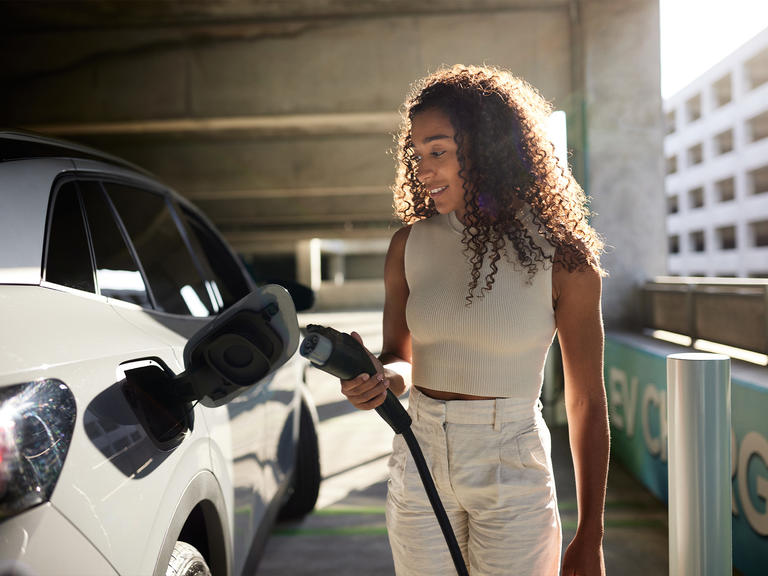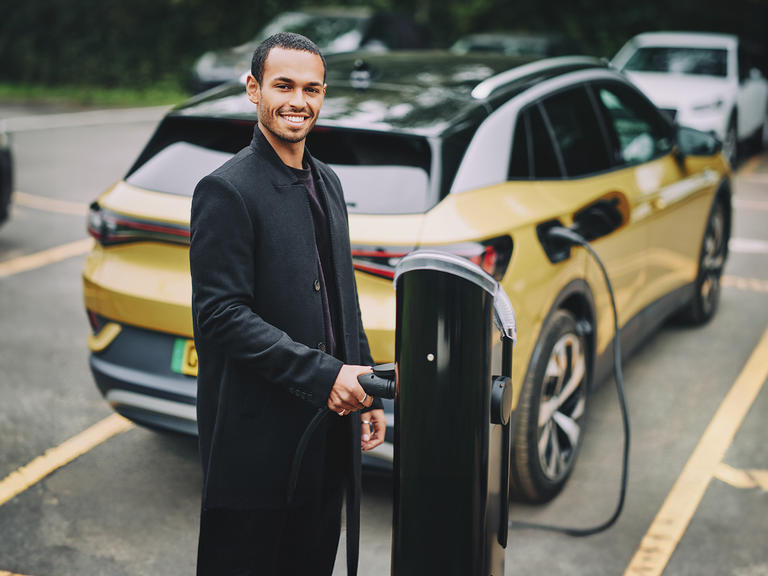Entering the electric era: the state of EVs in America

Our second annual HERE-SBD EV Index reveals that although electric vehicle adoption has grown across the United States, regional disparities remain.
Building on the foundations laid in last year's groundbreaking EV Index, a joint project between HERE and SBD Automotive, 2024’s interactive report showcases both the frontrunners and those falling behind in the evolving electric vehicle landscape.
Using an array of metrics, including the average power capacity of public EV (electric vehicle) chargers and how far a driver needs to travel to find a charger, the HERE-SBD EV Index paints a comprehensive picture of the current state of electric vehicle infrastructure at the US state and metropolitan level.
Robert Fisher, Principal at SBD Automotive — a global team of researchers and analysts dedicated to advancing the automotive industry — sat down with HERE360 to provide valuable insights into the latest findings.
The deal with Delaware
In one year, Delaware has rocketed from 15th to the top spot on the EV index with an overall score of 79.4. The reasons for this substantial jump include an exponential growth in EV sales, nearly twice as many chargers-per-road-length and a doubling of Delaware’s average charger power. No small feat, especially when you consider the state only has a population of just over a million people.
“It’s really amazing. Most of the time we see states moving a couple of positions here or there,” said Fisher. “But essentially, there are four states in New England that are focused on electrifying a corridor that will allow you to travel between New York City and Washington, DC – without having trouble charging your EV and Wilmington, Delaware is sitting right in the middle.”
Being one of the critical waypoints between the Big Apple and the US capital has also made the “First State” a target for federal NEVI (National Electric Vehicle Infrastructure) grants for high-power DC (direct current) chargers. Delaware also has an enticing rebate program, offering up to US$10,000 in combined state and federal incentives for electric vehicle purchases.
“Delaware has made a concerted effort to convince consumers to adopt EVs,” said Fisher.
Other states that saw a major uplift in their scores were Tennessee, Louisiana, Texas and Indiana.

Meanwhile in Michigan
Slipping nine points, Michigan’s ranking has dropped to 40th place, mainly due to a decrease in average charger power and the charger-to-EV ratio.
“Michigan is much more rural than New England or most of California,” said Fisher.
“Our US office is located in Ann Arbor, near Detroit. When my colleagues who own EVs attempt to drive northward on vacation, they’ve told me that they have trouble finding chargers that are working, and if they are operational, there are long wait times.
The vastness of the United States presents ongoing challenges in bridging the gap between urban and rural electric infrastructure, although overcoming this is not impossible.
“We’ve completed a lot of analysis of the maturation of charging networks in Europe to see how that might apply to the US,” said Fisher. “Typically what happens is you start off building out a network that fills a basic need to get from point A to point B — and then you can increase the density.”
Don’t mess with Texas
This year’s index introduces new insights, including the uptime of charge points and US metropolitan-level data. Major metropolitan areas like Los Angeles, New York, and San Francisco continue to lead in both AC and DC charging capacity; however, two metro areas stood out to Fisher.
“Houston's average charger power was really high, but in terms of chargers per person, they came in last place,” said Fisher. “You could surmise that the average person in Houston has no interest in EVs, but the data across the whole of Texas would say otherwise – the state seems to have a healthy appetite for electric mobility.
“So this means that the parties installing the chargers are going about it in a fairly advanced way – they are opting for fewer high-powered chargers rather than lots of low-powered ones. This is in line with what we would expect for a low-density metropolis like Houston, but they are still behind the curve overall.
“Chicago scored poorly on both rankings - the city has a low number of chargers per person, with very low average charging power. This would suggest they have focused on on-street charging rather than high-powered charging stations for long trips.”
Alleviating range anxiety
Still, the US has seen a 32% surge in charge points. Has this, we asked Fisher, helped to abate range anxiety?
“It is a lot easier to find a charge point this year compared to last, but there are still issues with charger maintenance,” he said.
As the HERE-SBD EV Index was being prepared, as many as 20% of chargers in states like Alaska, West Virginia and Hawaii were out of order.
“If one in five times that you stop at a charger, and there’s no way to charge, that could be quite frustrating,” said Fisher.
“There’s a lot of government money that’s being invested into repairing those chargers, but it’s going to take another two to three years before we get the service level back to where it needs to be, a minimum of 97%.”
NEVI say never
The NEVI Formula Program, initiated by the Infrastructure Investment and Jobs Act, has allocated US$5 billion in grants for a nationwide EV charging network. Despite its 2022 launch, public charge points are only now being deployed, with just 33 points opened so far.
“California benefited the most, from a pure dollar perspective,” said Fisher. “But did they need it? It was a natural market anyway.
“One of the states most disadvantaged when it comes to charging infrastructure is Mississippi. They have a very immature network – it’s difficult for people to drive across the state, even if you’re just passing through. They have received a decent amount of NEVI funding and I think that will improve things dramatically. But then again, we are two years into the NEVI program and there have only been 15 charging stations built across the country.
“Overall, a lot of the charge points that would have naturally built up over time have been delayed while they wait for the NEVI funding to come through. It is a really good idea, but it has slowed things down for the time being.”
What should automakers do in response to these challenges? When we spoke with Fisher last year, he hoped for more efforts to dispel myths surrounding EVs to better support consumers transitioning to electric mobility. Has his view changed in 2024?
“Rumor-wise, I think it’s only gotten worse,” said Fisher. “It’s kind of like Whack-A-Mole – as soon as you start to see one of the myths die down in the media, another one surfaces. Just yesterday, there was an op-ed talking about government heads needing to roll because the EV transition was a complete failure – and it isn’t true.
“According to some of our most recent surveys, most EV drivers are fairly happy and confident with the charging networks they have. What that demonstrates is that an EV driver begins to understand where they can charge reliably and quickly, and what times of day are best.
“It’s the people who don’t drive EVs who aren’t comfortable with it. They only see the negative news about charging and assume that it’s difficult, but in most cases, it isn’t that bad.”
Plugged in
Federal initiatives such as the NEVI Formula Program hold promise for improving nationwide charging networks, yet their delayed implementation underscores the complexities of transitioning to an electric landscape.
Looking ahead, the continued expansion and reliability of charging infrastructure will be crucial in overcoming range anxiety and dispelling myths surrounding EVs. As more states follow Delaware's lead, the United States can anticipate a more cohesive and accessible electric vehicle ecosystem, paving the way for a sustainable and electrified transportation future.
| The state of global EV charging and the role of AI |
| To explore further insights from this year's HERE-SBD EV Index, join us on October 24th for a free 60-minute webinar with Robert Fisher from SBD Automotive and Andrei Iordache from HERE. |
| Register now |
Have your say
Sign up for our newsletter
Why sign up:
- Latest offers and discounts
- Tailored content delivered weekly
- Exclusive events
- One click to unsubscribe



